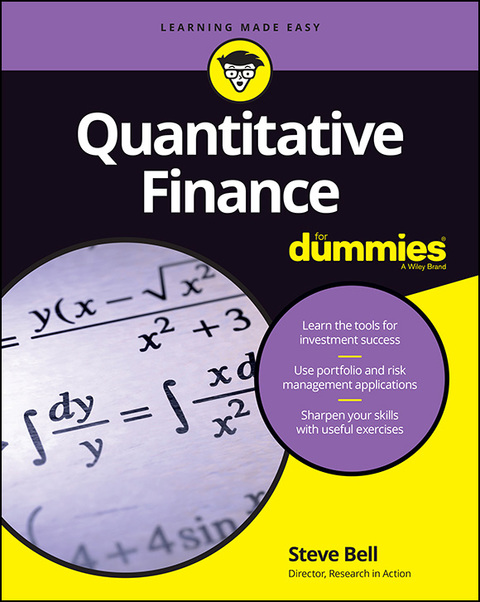Description
Efnisyfirlit
- Cover
- Introduction
- About This Book
- Foolish Assumptions
- Icons Used in This Book
- Where to Go from Here
- Part 1: Getting Started with Quantitative Finance
- Chapter 1: Quantitative Finance Unveiled
- Defining Quantitative Finance
- Wielding Financial Weapons of Mass Destruction
- Analysing and Describing Market Behaviour
- Managing Risk
- Computing, Algorithms and Markets
- Chapter 2: Understanding Probability and Statistics
- Figuring Probability by Flipping a Coin
- Defining Random Variables
- Introducing Some Important Distributions
- Chapter 3: Taking a Look at Random Behaviours
- Setting Up a Random Walk
- Averaging with the Central Limit Theorem
- Moving Like the Stock Market
- Generating Random Numbers on a Computer
- Simulating Random Walks
- Moving Up a Gear
- Reverting to the Mean
- Part 2: Tackling Financial Instruments
- Chapter 4: Sizing Up Interest Rates, Shares and Bonds
- Explaining Interest
- Sharing in Profits and Growth
- Taking the Pulse of World Markets
- Defining Bonds and Bond Jargon
- Swapping between Fixed and Floating Rates
- Chapter 5: Exploring Options
- Examining a Variety of Options
- Reading Financial Data
- Getting Paid when Your Option Expires
- Using Options in Practice
- Trading Options On and Off Exchanges
- Relating the Price of Puts and Calls
- Chapter 6: Trading Risk with Futures
- Surveying Future Contracts
- Seeing into the Future
- Rolling a Position
- Converging Futures to the Spot Price
- Using Futures Creatively
- Seasonality in Futures Prices
- Part 3: Investigating and Describing Market Behaviour
- Chapter 7: Reading the Market’s Mood: Volatility
- Defining Volatility
- Using Historical Data
- Shrinking Time Using a Square Root
- Comparing Volatility Calculations
- Estimating Volatility by Statistical Means
- Going Beyond Simple Volatility Models
- Estimating Future Volatility with Term Structures
- Chapter 8: Analysing All the Data
- Data Smoothing
- Estimating More Distributions
- Modelling Non-Normal Returns
- Chapter 9: Analysing Data Matrices: Principal Components
- Reducing the Amount of Data
- Applying PCA to Yield Curves
- Using PCA to Build Models
- Part 4: Option Pricing
- Chapter 10: Examining the Binomial and Black-Scholes Pricing Models
- Looking at a Simple Portfolio with No Arbitrage
- Pricing in a Single Step
- Branching Out in Pricing an Option
- Making Assumptions about Option Pricing
- Introducing Black-Scholes – The Most Famous Equation in Quantitative Finance
- Solving the Black-Scholes Equation
- Properties of the Black-Scholes Solutions
- Generalising to Dividend-Paying Stocks
- Defining other Options
- Valuing Options Using Simulations
- Chapter 11: Using the Greeks in the Black-Scholes Model
- Using the Black-Scholes Formulae
- Hedging Class
- That’s Greek to Me: Explaining the Greek Maths Symbols
- Rebalancing a Portfolio
- Troubleshooting Model Risk
- Chapter 12: Gauging Interest-Rate Derivatives
- Looking at the Yield Curve and Forward Rates
- Modelling the Interest-Rate
- Part 5: Risk and Portfolio Management
- Chapter 13: Managing Market Risk
- Investing in Risky Assets
- Stopping Losses and other Good Ideas
- Hedging Schemes
- Betting without Losing Your Shirt
- Evaluating Outcomes with Utility Functions
- Using the Covariance Matrix to Measure Market Risk
- Chapter 14: Comprehending Portfolio Theory
- Diversifying Portfolios
- Minimising Portfolio Variance
- Capital Asset Pricing Model
- Assessing Portfolio Performance
- Chapter 15: Measuring Potential Losses: Value at Risk (VaR)
- Controlling Risk in Your Portfolio
- Defining Volatility and the VaR Measure
- Constructing VaR using the Covariance Matrix
- Estimating Volatilities and Correlations
- Simulating the VaR
- Validating Your Model
- Including the Average VaR
- Estimating Tail Risk with Extreme Value Theory
- Part 6: Market Trading and Strategy
- Chapter 16: Forecasting Markets
- Measuring with Technical Analysis
- Making Predictions Using Market Variables
- Predicting from Past Values
- Chapter 17: Fitting Models to Data
- Maximising the Likelihood
- Fitting and Overfitting
- Applying Occam’s Razor
- Detecting Outliers
- The Curse of Dimensionality
- Seeing into the Future
- Chapter 18: Markets in Practice
- Auctioning Assets
- Looking at the Price Impact of a Trade
- Being a Market Maker and Coping with Bid-Ask Spreads
- Trading Factors and Distributions
- Part 7: The Part of Tens
- Chapter 19: Ten Key Ideas of Quantitative Finance
- If Markets Were Truly Efficient Nobody Would Research Them
- The Gaussian Distribution is Very Helpful but Doesn’t Always Apply
- Don’t Ignore Trading Costs
- Know Your Contract
- Understanding Volatility is Key
- You Can Price Options by Building Them from Cash and Stock
- Finance Isn’t Like Physics
- Diversification is the One True Free Lunch
- Find Tools to Help Manage All the Data
- Don’t Get Fooled by Complex Models
- Chapter 20: Ten Ways to Ace Your Career in Quantitative Finance
- Follow Financial Markets
- Read Some Classic Technical Textbooks
- Read Some Non-technical Books
- Take a Professional Course
- Attend Networking Meetings and Conferences
- Participate in Online Communities
- Study a Programming Language
- Go Back to School
- Apply for that Hedge Fund or Bank Job
- Take Time to Rest Up and Give Back
- Glossary
- About the Author
- Advertisement Page
- Connect with Dummies
- End User License Agreement






Reviews
There are no reviews yet.